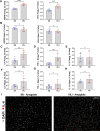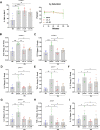Systemic interleukin-6 inhibition ameliorates acute neuropsychiatric phenotypes in a murine model of acute lung injury
- PMID: 36100846
- PMCID: PMC9469063
- DOI: 10.1186/s13054-022-04159-x
Systemic interleukin-6 inhibition ameliorates acute neuropsychiatric phenotypes in a murine model of acute lung injury
Abstract
Acute neuropsychiatric impairments occur in over 70% of patients with acute lung injury. Mechanical ventilation is a well-known precipitant of acute lung injury and is strongly associated with the development of acute delirium and anxiety phenotypes. In prior studies, we demonstrated that IL-6 mediates neuropathological changes in the frontal cortex and hippocampus of animals with mechanical ventilation-induced brain injury; however, the effect of systemic IL-6 inhibition on structural and functional acute neuropsychiatric phenotypes is not known. We hypothesized that a murine model of mechanical ventilation-induced acute lung injury (VILI) would induce neural injury to the amygdala and hippocampus, brain regions that are implicated in diverse neuropsychiatric conditions, and corresponding delirium- and anxiety-like functional impairments. Furthermore, we hypothesized that these structural and functional changes would reverse with systemic IL-6 inhibition. VILI was induced using high tidal volume (35 cc/kg) mechanical ventilation. Cleaved caspase-3 (CC3) expression was quantified as a neural injury marker and found to be significantly increased in the VILI group compared to spontaneously breathing or anesthetized and mechanically ventilated mice with 10 cc/kg tidal volume. VILI mice treated with systemic IL-6 inhibition had significantly reduced amygdalar and hippocampal CC3 expression compared to saline-treated animals and demonstrated amelioration in acute neuropsychiatric behaviors in open field, elevated plus maze, and Y-maze tests. Overall, these data provide evidence of a pathogenic role of systemic IL-6 in mediating structural and functional acute neuropsychiatric symptoms in VILI and provide preclinical justification to assess IL-6 inhibition as a potential intervention to ameliorate acute neuropsychiatric phenotypes following VILI.
Keywords: Anxiety; Cleaved caspase-3; Delirium; IL-6; Neural injury; Neuroinflammation; VILI.
© 2022. The Author(s).
Conflict of interest statement
The authors declare that they have no competing interests.
Figures






References
-
- Hager DN, Dinglas VD, Subhas S, Rowden AM, Neufeld KJ, Bienvenu OJ, Touradji P, Colantuoni E, Reddy DR, Brower RG, et al. Reducing deep sedation and delirium in acute lung injury patients: a quality improvement project. Crit Care Med. 2013;41(6):1435–1442. doi: 10.1097/CCM.0b013e31827ca949. - DOI - PubMed
-
- Girard TD, Shintani AK, Jackson JC, Gordon SM, Pun BT, Henderson MS, Dittus RS, Bernard GR, Ely EW. Risk factors for post-traumatic stress disorder symptoms following critical illness requiring mechanical ventilation: a prospective cohort study. Crit Care. 2007;11(1):R28. doi: 10.1186/cc5708. - DOI - PMC - PubMed
MeSH terms
Substances
Grants and funding
LinkOut - more resources
Full Text Sources
Medical
Research Materials

